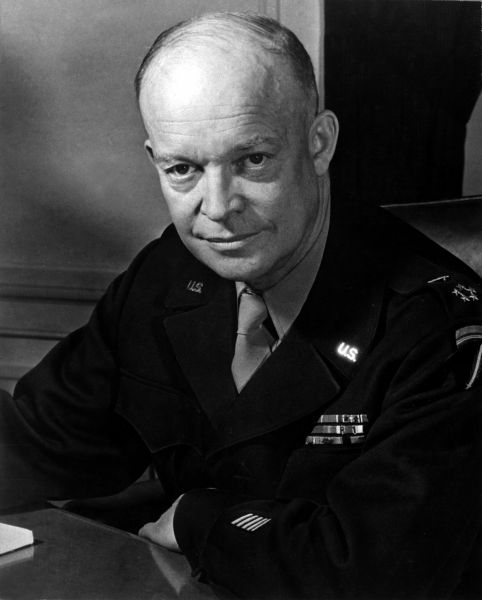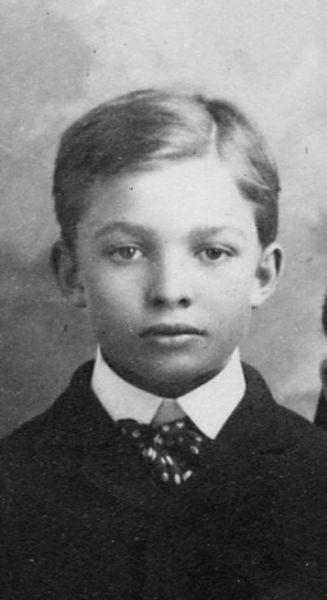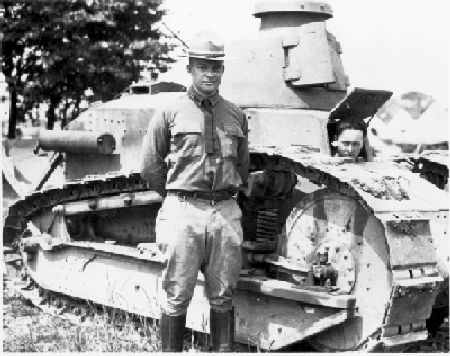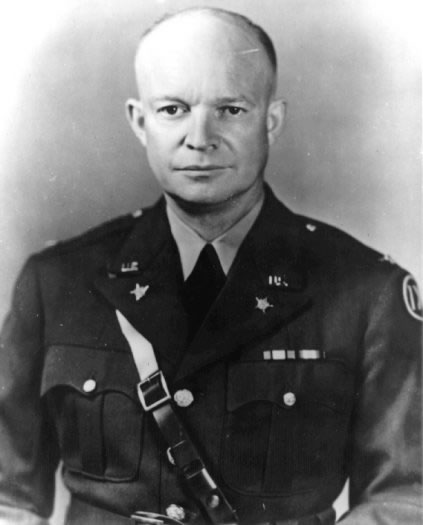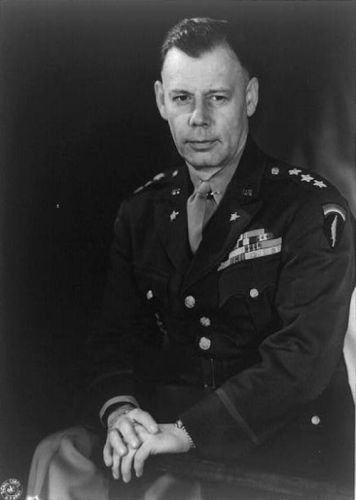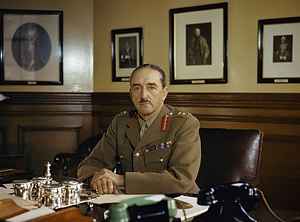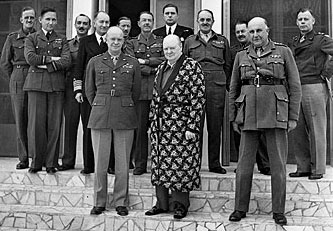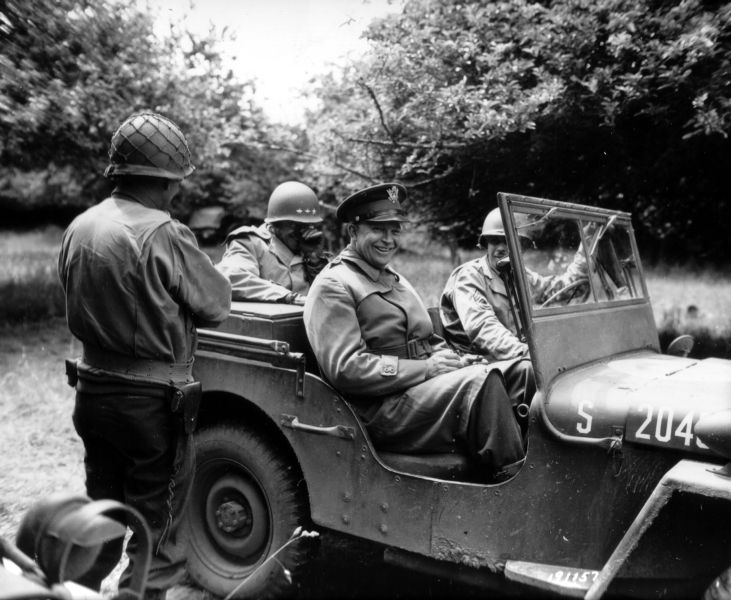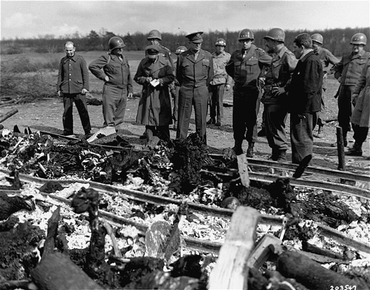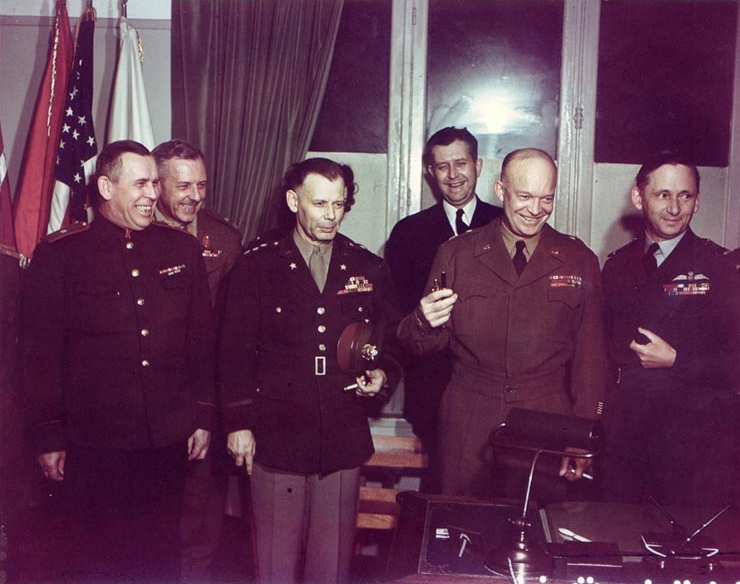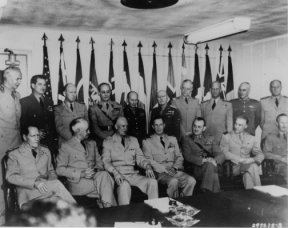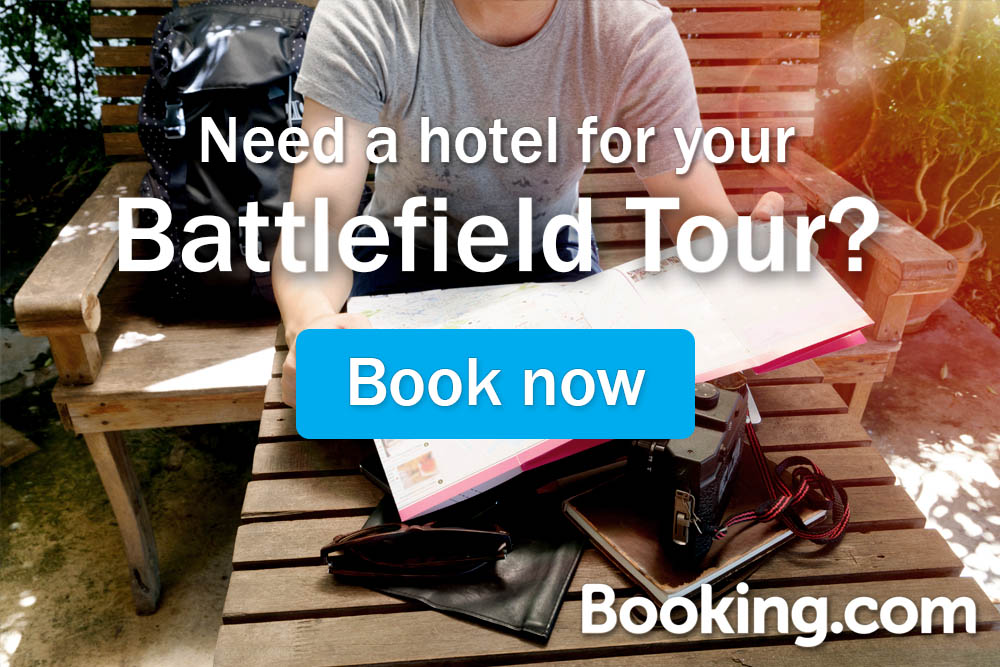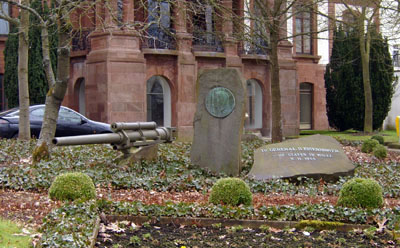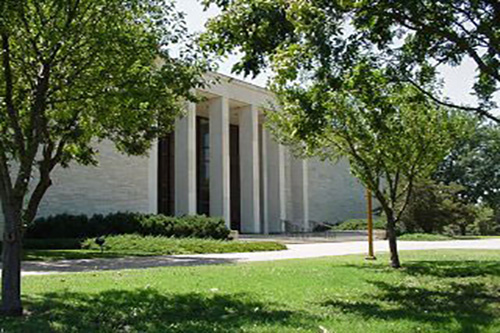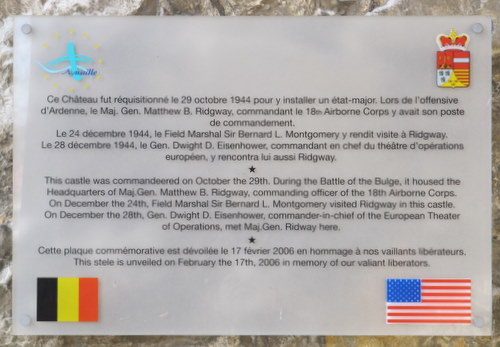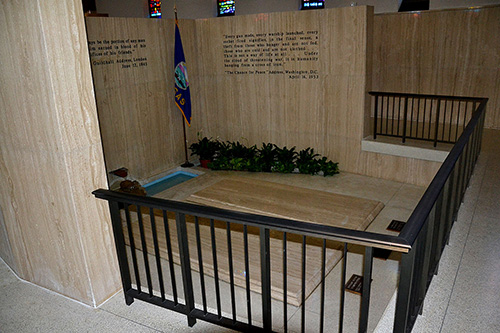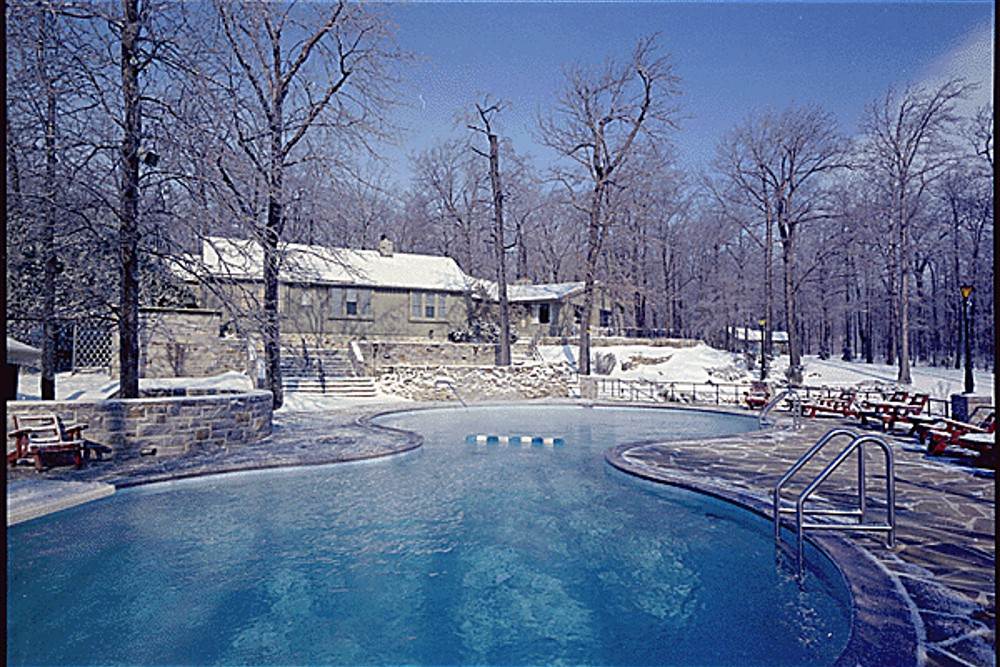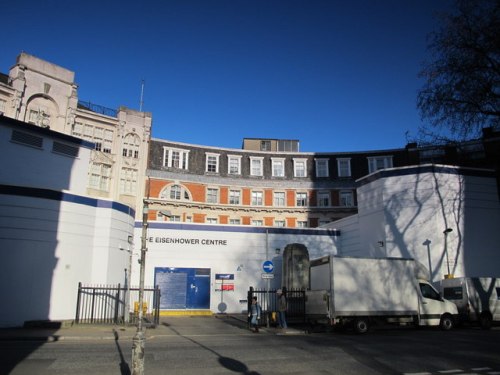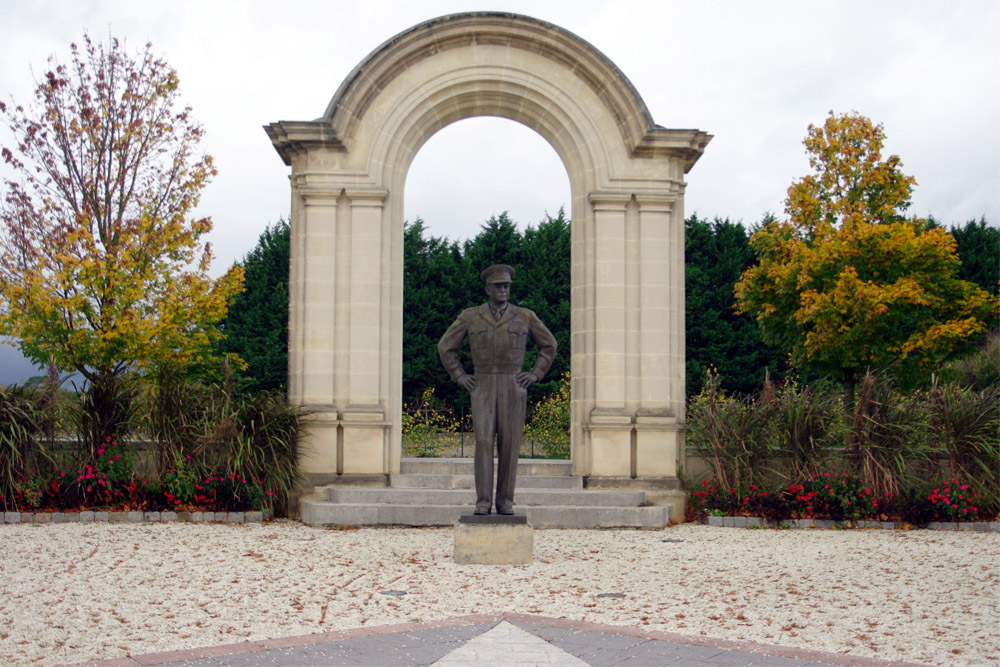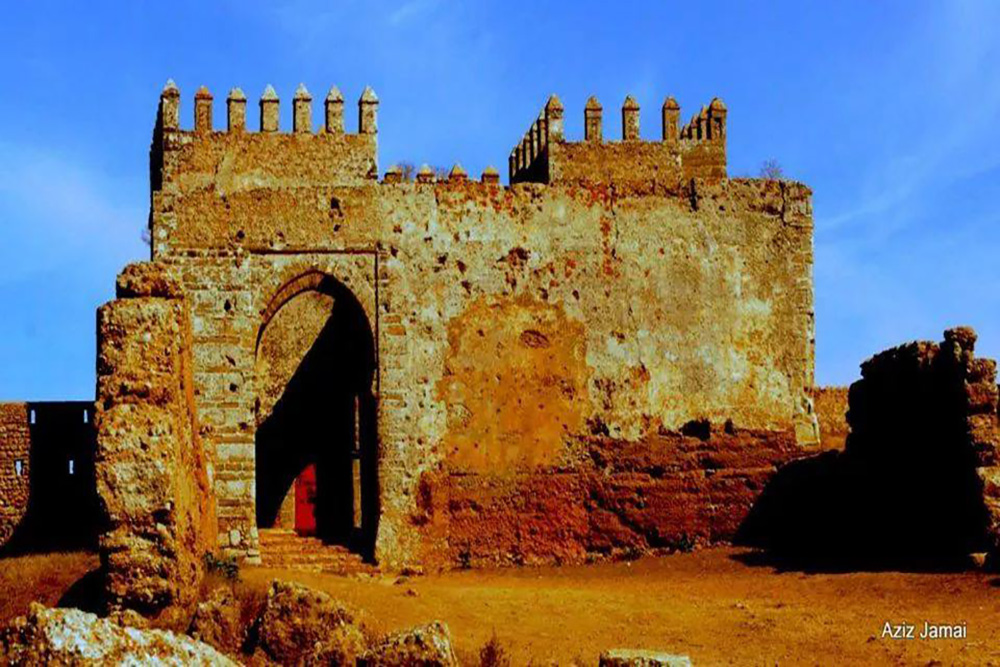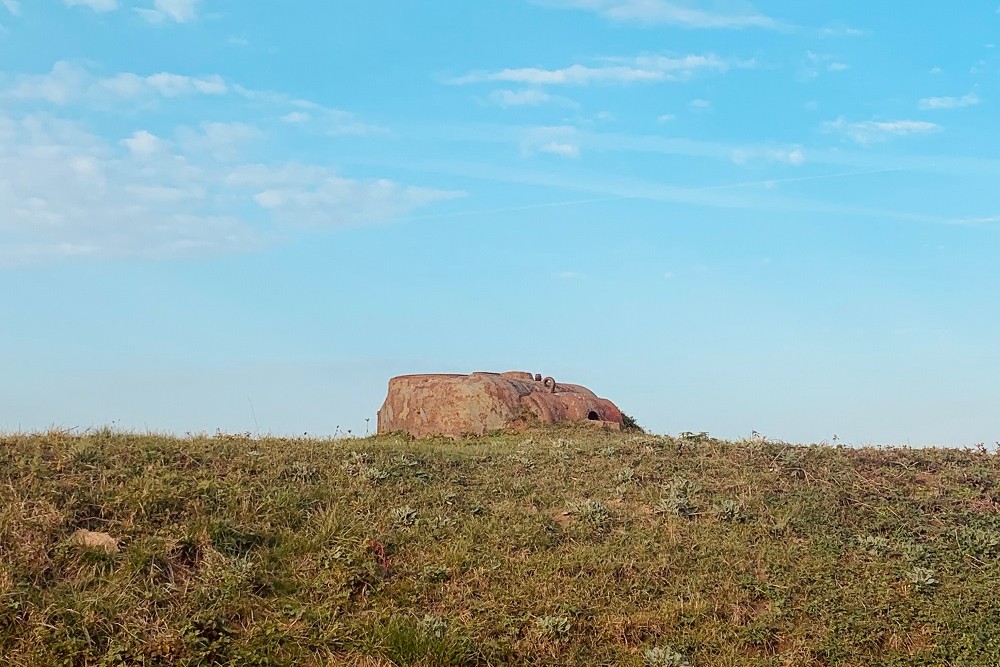Introduction
General of the Army Dwight Eisenhower has been both widely praised as well as criticized concerning his conduct as Allied Supreme Commander during World War Two. He made a lot of impression on the American population while his subordinates in Europe had their doubts about him. His task was not an easy one though. He had to plan and supervise the progress of the battle, he had to keep the home front satisfied about the progress of the war and find the right way to co-operate with his generals all at the same time. In particular the latter proved to be a tough task for Ike who spent much energy in maintaining the Allied alliance. After the war, Eisenhower would become the 34th president of the United States.
Images
Childhood and early career
Dwight David Eisenhower was the son of David Jacob Eisenhower and Ida Elizabeth Stover. His forefather, Hans Nicholas Eisenhauer was of German descent but had emigrated to the United States in 1741. Dwight Eisenhower was born October 14th, 1890 in Denison, Texas. He grew up in Abilene, Kansas with his six brothers. His parents attached much value to independency, honesty and hard work and Eisenhower was raised accordingly. He went to High School in Abilene, graduating in 1906. He immediately went to work in the Belle Springs Creamery but he would stay there for just a year.
In 1907, Eisenhower went to West Point Military Academy. Here, he proved to be a good cadet; he scored high marks both as a student and as an athlete. His capacities of leadership were particularly praised: he could bring a group together and keep it together and make his members enthusiastic for a common goal. His collegiality and good teamwork also impressed his class mates, Omar Bradley, James Van Fleet and Joseph McNarney, to name just a few. These three men would all rise to the rank of general during World War Two, causing this class to be nicknamed the class the stars fell upon. He graduated from West Point in 1915, holding the rank of Lieutenant. A year later, he married Mamie Geneva Doud with whom he had two sons: Dought and John.
Eisenhower served in the infantry until 1918 and attained the rank of Captain. He had not participated in the Pancho Villa Expedition on the Mexican border from 1916 to 1917 when the Americans attempted to arrest the leader of the Mexican revolution, Pancho Villa, nor did he take part in the First World War. He did hold the temporary rank of Lieutenant-colonel during that war though. After the Great War, he was degraded to his former rank of Captain but he was soon promoted to Major, a rank he would hold for the next 16 years as the American army was severely cut down in size as a result of the policy of isolationism America pursued after the First World War. During a number of years, Eisenhower studied the deployment of tanks in battle intensively. In this capacity, he made the acquaintance of George Patton who would serve as a general under him during World War Two.
Eisenhower worked in the Panama canal zone for General Fox Connor until 1924. Ike said himself he had learned much from him about military tactics and military history. Connor also predicted America would get in trouble with Japan and a new conflict would arise in Europe. He urged Eisenhower to attend the highly demanding General Staff School. The young major graduated as first out of his class of 245 officers. Subsequently he studied at the Army War College and the Army Industrial College. From 1933 to 1935 he was adjutant and shortly afterwards military advisor to General Douglas MacArthur, at that time Army Chief of Staff. In this period he was promoted to Lieutenant-colonel. In 1939, he trained the 15th Infantry Regiment and a year later he became Chief of Staff of 3rd Infantry Division and later on of 9th Corps. In June 1941, he became Chief of Staff of General Walter Krueger’s 3rd Army.
In August and September of that year, 3rd Army achieved great success during the Louisiana Maneuvers, a large scale exercise concerning movements and logistics. Eisenhower had drafted the plans for 3rd Army. The unit even made the press with its successes and so Ike was "spotted" by the War Department in Washington. He was promoted to Brigadier-general the same year.
Definitielijst
- First World War
- Took place from 1914 till 1918 and is also named The Great War. The conflict started because of increased nationalism, militarism and neo-colonialism in Europe. Two alliances battled one another during the 4-year war, which after a dynamic start, resulted into static trench warfare. The belligerents were the Triple Alliance (consisting of Great-Britain, France, and Russia; later enlarged by Italy and the USA, amongst others) on the one hand and the Central Powers (consisting of Germany, Austria-Hungary, Bulgaria and the Ottoman empire) on the other hand. The war was characterized by the huge number of casualties and the use of many new weapons (flamethrowers, aircraft, poison gas, tanks). The war ended in 1918 when Germany and its allies surrendered unconditionally.
- infantry
- Foot soldiers of a given army.
- isolationism
- US policy not to interfere with foreign affairs. This policy lasted more or less until the attack on Pearl Harbor (December 1941).
- Regiment
- Part of a division. A division divided into a number of regiments. In the army traditionally the name of the major organised unit of one type of weapon.
- revolution
- Usually sudden and violent reversal of existing (political) the political set-up and situations.
Images
The beginning of World War Two
December 7th, 1941, the United States were dragged into World War Two after an attack by the Japanese on the American naval base at Pearl Harbor. President Franklin Delano Roosevelt declared war on Japan and subsequently, on December 11th, Adolf Hitler chose Japan’s side. As a result of the American shortages in men and material, a large scale operation against either Japan or Germany could not be undertaken yet. This gave the army ample time to consider how to take on the enemy in the best way possible. Eisenhower also played a role in this after his transfer to the General Staff in Washington. Here he became subordinate to General George C. Marshall, a situation that was to last during the entire war. Until June 1942, he was employed at the War Plans Division, later renamed Operations Division, which was engaged in planning the war against Japan and Germany.
Eisenhower and Marshall considered Germany the most important enemy of the Allies as opposed to the American public opinion which, with Pearl Harbor still very fresh on its mind, very much preferred a massive effort against Japan. The two generals were convinced though that a strong alliance was required to win the war. If the United States should make Japan its priority, the Red Army would remain Germany’s only adversary and Marshall considered this too great a risk. Germany had to be fought on two fronts. Concerning the war against Germany, they considered an invasion of Europe by means of a Channel crossing the most suitable way to defeat Hitler.
Marshall became more and more convinced of Eisenhower’s capabilities and increasingly trusted him. He began to consider him the most suitable person to command the American forces in Europe so Eisenhower could implement the military strategy Marshall envisaged. On June 8th, 1942, Eisenhower presented him with the "Instructions for the Commanding General, European theatre". Three days later, Marshall informed Eisenhower he had been given command in Europe.
Marshall‘s decision immediately gave rise to criticism. Critics and subordinates blamed Eisenhower for his lack of battle experience. They wanted to see a real soldier as their commander as they considered Eisenhower a military theoretician, more suitable for a staff position than for supreme command. The British also had mixed feelings over Eisenhower’s appointment initially. This however was not caused by his inexperience but rather by his ideas about the strategy to be pursued. As mentioned before, the Americans wanted a crossing of the Channel, followed by a large scale offensive in the west. The British, headed by Churchill saw little good in this plan. They remembered the campaigns in western Europe of the First World War and preferred a gradual weakening of Germany. The American plan was dismissed as a castle in the air.
In the end the American plans were postponed. The British had managed to convince the Americans that it was much too early for a Channel crossing. Moreover the required material and men were not yet available. The Americans only had two divisions in Europe. In the interest of morale at the home front however, Roosevelt wanted American troops to get into the action, so Marshall and Eisenhower gave in to Churchill’s plans and a landing in North-Africa was prepared.
Definitielijst
- First World War
- Took place from 1914 till 1918 and is also named The Great War. The conflict started because of increased nationalism, militarism and neo-colonialism in Europe. Two alliances battled one another during the 4-year war, which after a dynamic start, resulted into static trench warfare. The belligerents were the Triple Alliance (consisting of Great-Britain, France, and Russia; later enlarged by Italy and the USA, amongst others) on the one hand and the Central Powers (consisting of Germany, Austria-Hungary, Bulgaria and the Ottoman empire) on the other hand. The war was characterized by the huge number of casualties and the use of many new weapons (flamethrowers, aircraft, poison gas, tanks). The war ended in 1918 when Germany and its allies surrendered unconditionally.
- invasion
- Armed incursion.
- offensive
- Attack on a smaller or larger scale.
- Red Army
- Army of the Soviet Union.
- strategy
- Art of warfare, the way in which war should be conducted in general.
Images
Campaign in Africa
On June 25th, 1942, Eisenhower was appointed Supreme Commander Allied Forces in North-Africa. General Mark Clark became his deputy. Both men stayed in London in the summer of 1942. Here they were very busy planning an Anglo-American offensive on the shores of North-Africa. Meanwhile, Eisenhower got his headquarters together. General Walter Bedell Smith became his Chief of Staff. He had all his new personnel investigated thoroughly, whether they were American or British. He required everybody to set national feelings aside in order to achieve a mutual goal. In doing so, Eisenhower developed a new form of command structure, i.e. the unity of command. Initially, the British felt very unfamiliar with Eisenhower’s new structure. They felt superior over the Americans who were considered greenhorns on the battlefield. The British would have to teach them first how to wage war. In contrast, the Americans thought the British had already suffered too many defeats to make good teachers. These differences of opinion did not match Eisenhower’s ideas of an allied unity. Eisenhower went rather far in this way of thinking. He wanted for instance to equalize training, feeding and conduct of British and American soldiers in order to prevent major differences between them. American soldiers were paid more and had better food, a difference Eisenhower wanted to straighten out.
On November 8th, 1942, the North-African campaign was launched, codenamed Operation Torch. It was Eisenhower’s baptism of fire. The Allies encountered a tricky issue, the presence of Vichy-French in North-Africa who collaborated with the German occupant. The relations between the British and French were not too good after the attack by the British on the French fleet in 1940 (the British had decided to cripple the fleet to prevent it from falling in German hands). It was decided the attack would be a predominantly American affair. President Roosevelt had attempted to make it clear that the Americans were coming as friends rather than conquerors but this message had not gotten through everywhere. In Casablanca and Oran, fighting erupted between French and American troops, in Casablanca, the French even put up a fierce resistance for three days. Maréchal de France, Philippe Pétain, president of Vichy-France, denounced Operation Torch and a conflict loomed.
Subsequently, Eisenhower decided to contact Amiral de la Flotte, François Darlan, Commander-in-Chief of the French fleet. He was not popular among the Allies and did not enjoy warm relations with the British. But Eisenhower did not see any other possibility but to promise him he would be recognized as the head of the French government. Only then were the Vichy-French in North-Africa ready to side with the British and Americans. Here, Eisenhower did not only fulfill the task of supreme commander but of a diplomat as well. Public opinion in England and the United States reacted bitterly however and Eisenhower met with negative criticism. Roosevelt defended Ike by explaining the agreement was a purely military one in order to minimize the number of casualties as much as possible and to accelerate the advance. Criticism for Eisenhower diminished after the murder of Darlan by a French monarchist around Christmas 1942. Nonetheless, the first few months as supreme commander did not pass smoothly for Eisenhower. He wrote about this: "I feel like a cross between a one-day-soldier, a would-be statesman, a politician and a diplomat."
In the first months of the North-African campaign, the new alliance did not yet operate in the way Eisenhower had wished for. The commander of the ground forces, British General Kenneth Anderson, was the authorized to negotiate with the British government behind Eisenhower’s back. Especially General Patton thought this went way too far. He voiced his opinion that the Americans were sold for a dish of potage. He felt dominated by the British and found followers among his officers. Eisenhower reprimanded Patton for his language that did not match the Allied way of thinking he strove for.
In December 1942, criticism against Eisenhower increased. The advance in Africa did not proceed quickly enough. The rainy season made advancing difficult. The British, with Fieldmarshall Alan Brooke in the lead, harbored more and more doubts about Eisenhower. His lack of experience became an important argument again. For someone who had never commanded a battalion in battle, the task of supreme commander under these circumstances was too heavy, according to Eisenhower’s critics. In addition, Eisenhower was blamed for involving himself too deeply in administrative issues, causing him to focus too little on the military progress of the war. General Marshall came to Eisenhower’s rescue but did advise him to focus more on tactical warfare and avoid diplomatic issues more often.
In February 1943, a new command structure was established; Eisenhower was given three British subordinates, each with more experience than he had himself: Harold Alexander on behalf of the army, Arthur Tedder of the air force and Andrew Cunningham of the navy. The British were very pleased with this arrangement and hoped to get the advance going again. According to the British allies, Eisenhower could now focus wholeheartedly on political and interallied issues. Meanwhile, the press put the young alliance to the test after the battle at Kasserine, Tunisia had been lost in February 1943. According to some American reporters, the British had not done enough to help the inexperienced American troops. The German propaganda played on this by inflating the strenuous cooperation between British and American officers at Kasserine further. Eisenhower looked into it and decided something had to change. He fired General Lloyd Fredenhall who he held accountable for the defeat at Kasserine and he put General Patton in charge of the American 2nd Corps.
The defeat at Kasserine was explained away by the British as having been due to incompetent leadership of Eisenhower. He was blamed again for not having sufficient experience and busying himself more with politics than with the battles. At that moment, a rumor even circulated to the effect that Roosevelt, Stalin and Churchill had discussed Eisenhower’s possible replacement at the Casablanca Conference (January 14th to 24th, 1943) in order to put the drive back into the advance. Eisenhower maintained his position but a fast American success was needed to silence the criticism against the supreme commander and the American soldiers.
The American troops continued playing their role in the Tunisian campaign. After Fredenhall had been fired, 2nd Corps scored better results. Patton had commanded the Corps successfully during the fighting in the region around Gafsa, El Guettar and Maknassy (April-May 1943). He had done well and was relieved as commander of 2nd Corps by General Omar Bradley so he could prepare for the invasion of Sicily. Eisenhower managed to convince Alexander to deploy the Americans in the vicinity of Bizerta on the northern coast of Tunisia. Bradley captured the port and later on Tunis as well. Montgomery caused vexation by claiming this success but Eisenhower particularly praised the spirit of unity among the Allies.
Definitielijst
- Casablanca Conference
- Conference between the leaders of Great Britain and the USA (Churchill and Roosevelt). The conference took place from 14 to 24 January 1943.
- invasion
- Armed incursion.
- offensive
- Attack on a smaller or larger scale.
- propaganda
- Often misleading information used to gain support among supporters or to gain support. Often used to accomplish ideas and political goals.
- resistance
- Resistance against the enemy. Often also with armed resources.
Images
Campaign in Italy
The Allied spirit of unity did not emerge during the planning of the operations on Italian soil. While the plans for the invasion were being drafted, Eisenhower’s attention was still focused on Africa and the British, Fieldmarshall Alan Brooke in the lead, used the opportunity again to indicate that they considered Eisenhower incapable. At some moment in time, Eisenhower even had a conflict with Winston Churchill when the British Prime Minister doubted the outcome of the operation because of the German strength on Sicily. Meanwhile, Montgomery attempted to draw command of the ground forces towards himself with a plan for the invasion, drafted by him, making him the most important commander. Eisenhower only approved the plan but retained overall command himself. The Americans, led by Eisenhower remained true to their spirit of unity. They did however wish more publicity for the supreme commander and the American troops.
From the invasion of Sicily onwards, Eisenhower and others with him, were beginning to be irritated by Montgomery. He did not doubt his capabilities but he deemed the Englishman conceited as he did not seem willing to look for compromises. The American commanders, Bradley and Patton in the lead, blamed this on Eisenhower’s conduct who gave in too much to the British in their opinion. This feeling was even enhanced when Eisenhower praised Montgomery a few days after the landing when the latter only had managed to make slow progress. Patton on the other hand did make good progress with his 7th Army. He was reprimanded though for being hard to reach by his superior. Eisenhower also ordered him to investigate the mission of the paratroops of the 82nd Airborne Division on July 9th, 1943 which had ended in disaster as troops had come under friendly fire.
Eisenhower’s reprimand hardly made any impression on Patton however. Communication with his supreme commander remained poor and he made clever use of it during his race against Montgomery unfolding on the island. The alleged pro-British attitude of Eisenhower could have been the cause of Patton’s determined stand. Meanwhile, Eisenhower faced a conflict with the B.B.C. The supreme commander had announced to the press that the battle on Sicily proceeded more easily for the Americans than for the British. The B.B.C. sent a message to the world to the effect that the British were having a hard time while their American allies were enjoying the summer because of poor resistance. Eisenhower was rather angry about this as the message was detrimental to the Allied cooperation. After talks with Churchill, it was decided that reports on both sides should be more balanced.
During the Sicilian campaign, Eisenhower had to cope with another conflict. While on a visit to a field hospital, Patton had come down hard on two soldiers suffering from shell shock and had even hit them in the face. The incident became known as the slapping incident and Eisenhower was forced to act strongly. He discussed the incident with military authorities and in particular with Chief of Staff Marshall. He was of the opinion that this action could not be tolerated but at the same time he needed Patton for the future progress of the war. Patton received a letter from Eisenhower who reprimanded him and demanded apologies but a few weeks later, the same thing happened again. Patton was relieved and sent to England where he spent a year kicking his heels and command of the invasion of mainland Italy was given to General Mark Clark.
Prior to the invasion of mainland Italy, Eisenhower negotiated with the Italians. As a result of reactions to the Darlan deal in North-Africa, Eisenhower was obliged to discuss each development with Roosevelt and Churchill, something he did not like at all. In the end, negotiations with the Italians did not lead to much initially. The Italians did want to surrender, provided they would be informed about the Allied plans but to Eisenhower, this was anathema. The negotiations were extended and an important role was reserved for General Maxwell Taylor. On September 8th, 1943, the Italians surrendered unconditionally and a day later, the American 5th Army landed in Salerno near Naples.
Initially, Eisenhower was pleased with the landings and the Italian surrender. It had caused the Germans to transfer additional forces to the peninsula, leading to a weakening of the German defenses elsewhere. The Allied advance proceeded extremely slow after the landings, something which evoked criticism against Eisenhower again as to his conduct as supreme commander. Another point of criticism was that too little attention was being paid to the campaign in Italy. This campaign has always taken second place to the planning of Operation Overlord, the Allied invasion of Normandy which the Americans had preferred all along. This in contrast to the British who attached more importance to the Italian campaign; in particular Churchill with his "soft underbelly" theory. Eisenhower met the British Prime Minister halfway though with the landings at Anzio, close to Rome on January 22nd, 1944. Meanwhile, on December 6th, 1943 Eisenhower had been given command of Operation Overlord, despite the fact that the British had preferred to see General Marshall in that role as they had more confidence in his capabilities.
Definitielijst
- invasion
- Armed incursion.
- resistance
- Resistance against the enemy. Often also with armed resources.
Images
Campaign in western Europe
From January 1944 onwards, Eisenhower was engaged in the preparations for Operation Overlord. Just like during the preparations for Operation Torch, Eisenhower attempted to create a sense of unity among his British and American associates. He arranged American coffee breaks as well as British high teas for instance. The first dispute in the preparation for the invasion was the tactical bombing, known as the Transport Plan. Eisenhower and Tedder wanted Important locations in France, the Low Countries and western Germany bombed to disrupt the German supply lines. Churchill, supported by Air Chief Marshall Arthur Harris opposed this due to the losses among French civilians this would cause. They preferred bombing the German war industry to weaken the enemy in this way. Eisenhower also wanted to have R.A.F. Bomber Command under his direct command, something Churchill did not want either. The British Prime Minister considered the R.A.F. a national symbol which had to remain independent. Eisenhower told Churchill he "would go home" if he did not get what he wanted. Ultimately, this dispute was solved with the appointment of Air Chief Marshall Arthur Tedder as commander of the air force under Eisenhower.
Eisenhower also took the decision to postpone Overlord until June because of the more suitable moonlight and to assure that sufficient vessels would be available. In conjunction with Montgomery, he also decided to add two additional divisions to the order of battle, in addition to the three divisions as initially proposed by the planners of Overlord.
After Eisenhower had postponed the invasion on June 5th, it was launched the day after. Following the successful landings, a large part of the authority lay, for the time being, on Montgomery’s shoulders. He commanded the ground forces and Eisenhower had no headquarters yet on the continent. Montgomery was tempted by this situation to urge putting him in command of all Allied land forces, even when Eisenhower would establish his headquarters on the mainland. In Montgomery’s view, Eisenhower still was not sufficiently capable for the supreme command. According to Montgomery, Eisenhower would have to become some sort of a president-commissioner.
Eisenhower however was far from satisfied with the achievements of the British fieldmarshall. Montgomery wanted to capture the Normandy port of Caen on D-Day itself but in this he failed. What followed was an extremely slow advance while the area around Caen was very important to the Allies. The airfields the air force needed so desperately were situated here. Meanwhile Montgomery did demand maximum support of his supreme commander and he continuously coveted his position. He did not only irritate his superior but also his colleagues. During the battle in Normandy, Eisenhower’s patience was frequently put to the test. He is said to even have considered replacing Montgomery but he would have abstained for fear of the public opinion. The strenuous struggle in Normandy caused vexation among the British and the Americans. Joseph Goebbels attempted to exploit this in his propaganda, something which caused a lot of work for Eisenhower. He was the man who had to keep the alliance together, an extremely important and difficult task.
Early August 1944, the Allied bridgehead finally started moving. Patton’s 3rd Army could finally join the battle. The break out in Normandy diverted the attention from the command structure and the alliance somewhat. This caused a little more quiet around Eisenhower. It would not last long however as a fresh discussion would erupt among the commanders as to strategy and supply.
The problems with the Allied supply system, caused by the overstretched supply lines running all the way from the Normandy beaches, made it impossible to continue the offensive on all fronts. Montgomery claimed he could end the war before Christmas 1944. The only things he needed were priority and supplies. Using these, he would force a breakthrough, capture the bridges across the rivers in the Netherlands and race across the German plain with his 21st Army group straight to Berlin. Ending the war in 1944 might have saved a lot of lives, military, civilian and of inmates of concentration camps. In addition, many cities, homes and public buildings would be saved from destruction. Initially, Eisenhower did not give in to Montgomery’s demands but later on acceded to his plans which would ultimately lead to Operation Market Garden.
The cooperation between the Allies now came under severe pressure. Generals Bradley, Patton and Devers could hardly stomach Montgomery getting all priority while the Americans were relegated to second place although they possessed the largest western forces. Again Eisenhower had to cope with the fragile relations between his subordinates. Contrary to Normandy, he did not succeed this time in having their cooperation run smoothly. During press conferences, mutual reproaches were voiced and this also revived the discussion about Eisenhower’s function. This time, the British were being backed by the Americans, including Patton. General Douglas MacArthur took Eisenhower’s side by calling him "the best clerk I ever had," referring to Eisenhower’s former function of staff officer.
Despite Bradley’s warnings for a possible failure of Operation Market Garden, the operation was launched anyway in September 1944. Eisenhower did demand though that Montgomery would exchange Berlin as final target for Arnhem and subsequently capture Antwerp, partly solving the supply problems. Market Garden ended in disaster and Bradley called it "Eisenhower’s biggest tactical blunder." The Americans now hoped that Eisenhower would give them more priority but this was not to be. Ike now switched his attention to Antwerp, again shifting the focus to the British sector. At the end of September, Eisenhower lost his temporary command of the air force as well which he had received for D-Day and the breakout out of the bridgehead.
Early October, Montgomery also made a renewed effort to draw supreme command to himself. He informed General Marshall that Eisenhower was not the right man in the right place. He was looking for compromises too often, something which suited a politician better than an Allied supreme commander. Montgomery considered the way Eisenhower executed his task unsatisfactory and presented himself as the person of choice for the job. Marshall and Eisenhower were furious and Ike let Monty be known he would be better off concentrating on the capture of Antwerp. In November, Eisenhower paid a visit to Belgium where he drew international attention by speaking about Auffanglager Breendonck the Germans had used as a concentration camp. It was the first time the Allies had encountered such a camp.
During the summer and autumn of 1944 the relations within the Allied camp were not too good. They would be really put to the test in the winter, which must have cost Eisenhower a lot of energy and headaches. The Germans had discovered a weak spot in the Allied defensive line, the Ardennes and launched a counter attack against it, known as the Battle of the Bulge. Once again, the British blamed the Americans for having been too naïve as to the strategy of the broad front, the reason for the weak defense of the Ardennes. Yet Eisenhower refused to change his tactics substantially, although he did indicate to pay more attention to the defense of the broad front, instead of considering the offensive aspect of this strategy. Eisenhower’s decision to transfer the 82nd and 101st Airborne Division to the Bulge immediately, later strengthening them with the 7th and 10th Armored Division proved to be the correct one. Where for instance Bradley, Hodges and Montgomery did not see the seriousness of the situation quickly enough, Eisenhower did just that. Ike’s freedom of movement was limited though during the German offensive because massive panic erupted among the American forces about Germans disguised as Americans. They would have perpetrated an attempt on the supreme commander although in retrospect, this had never been a goal of this German secret operation.
Bradley’s forces had been split by the German breakthrough and Eisenhower decided to transfer the American 1st and 9th Army to Montgomery, something that did not come lightly to Bradley. He considered it a slap in the face by Eisenhower. He blamed him for siding with the British too often and too little with his fellow countrymen. Patton shared Bradley’s view. The relationship between the various generals had deteriorated again. The crisis was ultimately solved by a daring and exceptional maneuver by Patton and his 3rd Army, swiveling 180 degrees around and advancing towards Bastogne. On January 26th, the offensive came to an end.
As a result of the Ardennes offensive, relations between Eisenhower and Marshall had cooled a little. Marshall had demanded a quick end to the war in Europe and Eisenhower had failed to make it happen. Now Marshall had to account for it to the American authorities. Ike wanted to end the war quickly and wanted to have the Ruhr area captured in the spring of 1945. Montgomery did not agree with this and wanted to clear the entire west bank of the Rhine in his sector first. Eisenhower indicated Montgomery had to keep quiet during the last months of the war. Eisenhower did decide however that 9th Army remained under British command, making Bradley furious. "Americans fight and die in Europe. We have 61 divisions while the British have 15 under strength divisions. Why must we continue giving and giving?" Bradley even threatened to resign but Eisenhower indicated this was to no one’s advantage, something Bradley understood too later on.
Meanwhile, Churchill urged Eisenhower to advance to Berlin and Prague. The capture of these cities would be the ultimate reward for the Allies. Eisenhower considered such an enterprise far too risky and "left Berlin to the Russians." This was also caused by his fear for a Nazi stronghold in southern Germany, the Alpenfestung although in retrospect there was no question of such a thing. He wanted to maintain the zones of occupation which had been laid down at the Yalta Conference and wished to end the war without unnecessarily sacrificing too many lives. In March, the Allies crossed the Rhine and Patton as well as Montgomery wanted to push through to Berlin. Again, Eisenhower indicated that this was no option, more so as he had sent a message to Stalin on March 28th to the effect that Berlin should be turned over to the Russians. Especially the British were very upset about this: they thought Eisenhower had pursued politics while he, being the commander of the Allied forces, had no authority whatsoever to do so. In Ike’s words, he had discussed this with Stalin as supreme commanders between themselves. Finally, on May 7th, 1945, the war in Europe drew to an end.
On April 12th, Eisenhower had visited Camp Ohrdruf. He was severely shocked over what he discovered there. Later he wrote he had never been able to describe the emotions he felt seeing these Nazi horrors with his own eyes. He had never been in a shock like that as in that moment. Eisenhower wanted to visit a concentration camp himself so he could gather evidence in case the Nazi cruelties would be explained away as Allied propaganda in the future.
After the German surrender, Eisenhower wanted to continue the alliance with the British and the Russians. In this he differed with most western allies, especially with Churchill, Montgomery and Patton who already foresaw problems with the Communists. Eisenhower also launched the program of deNazification. It involved tracking down and persecuting important Nazis and others were stripped of their functions. Nazi organizations were disbanded and a new location was found for displaced persons. That was to the detriment of German citizens who had to atone for the suffering their country had caused. This again led to differences of opinion between Eisenhower and Patton who did not stick to the guidelines for deNazification laid down by Eisenhower. Patton refused for instance, to strip some Nazis of their functions in the interest of reconstruction.
Definitielijst
- Alpenfestung
- Fortification in the Alps. The first development spotted by the Americans in 1944. The Americans feared a stronghold in the Alps as a last resort of the Nazis. The plan was covered in mystery. On the one hand the Alpenfestung might be the last SS stronghold which could lead to defeat of the Allied forces. Enormous arms depots were built and Nazi elite troops would be able to hide everywhere in the Alps and cause death and despair behind enemy lines, sometimes even in allied uniforms. This terrifying development was fed by German propaganda trying to lure the American forces towards the Alps and away from the Rhine. Although the British warned against this, the Americans decided to divide their forces and had them advance towards Berlin as well as the south. The Alpenfestung turned out, however, to be nothing but a spectre.
- Ardennes offensive
- Battle of the Bulge, “Von Rundstedt offensive“ or “die Wacht am Rhein“. Final large German offensive in the west from December 1944 through January 1945.
- Bomber Command
- RAF unit which controlled strategic and sometimes tactical bombing (as in Normandy)
- concentration camp
- Closed camp where people are being held captive that are considered to be anti- social, enemies of the state, criminal or unwanted individuals. These groups mostly do not get a fair trial or are condemned to doing time in a camp.
- D-Day
- The day of the long awaited invasion of western Europe in Normandy, France, 6 June 1944. After a long campaign of deception the allies attacked the coast of Normandy on five beaches to begin their march on Nazi Germany. Often explained as Decision Day, though this is entirely correct. The D stands for Day as generally used in military language. In this case it means an operation beginning on day D at hour H. Hence “Jour J“ in French.
- deNazification
- Post war policy of the allies in Germany to punish Nazi war criminals and to remove known Nazis from positions of power or public service.
- invasion
- Armed incursion.
- Nazi
- Abbreviation of a national socialist.
- offensive
- Attack on a smaller or larger scale.
- propaganda
- Often misleading information used to gain support among supporters or to gain support. Often used to accomplish ideas and political goals.
- strategy
- Art of warfare, the way in which war should be conducted in general.
Images
Post war career
After the war, Eisenhower met a lot of praise in the United States as to his conduct as supreme commander. He had grown into a popular personality. Between 1945 and 1948, he served as Chief of Staff of the American army, replacing General Marshall. In this capacity he was charged with the demobilization of the American forces that were scattered all over the world and many soldiers had to return home. After the war, Germany was divided into four zones of occupation. Eisenhower was appointed Military Governor of the American zone. He advocated the Morgenthau plan which entailed that Germany would be split in two states where the industry should be dismantled and important industries would become the joint possession of the victors. This way they wanted to prevent Germany to wage a new war in the future. In the end, the plan was rejected.
On February 7th, 1948, he left the army to become head of Columbia University. 1948 also was the year Eisenhower published his memoirs of the Second World War. His Crusade in Europe is considered worldwide as one of the best biographies, written by an American military man. Eisenhower held the function of Head of Columbia University for about three years. In 1950, Eisenhower, at the request of then incumbent president Harry Truman, became supreme commander of NATO. His task consisted of establishing a multinational (western) armed force that could make a contribution to the defense of a still severely damaged Europe against advancing Communism. During the war, Eisenhower had shown he was capable of letting people work together towards a mutual goal. Now, he managed again to blend various nationalities into a strong organization. He left his NATO post on May 31st, 1952 to return as head of Columbia University. His second term would last only a year because he would enter the world of American politics.
Eisenhower was also compromised after the war though. He allegedly has been indirectly responsible for the death of about one million German prisoners of war. The Allied commander introduced a new designation for German prisoners of war in order to dodge the Geneva Convention. This convention stipulated rules for the treatment of prisoners of war. For instance, the Germans should have the same rations as American soldiers. By renaming these prisoners of war (POW) to Disarmed Enemy Forces (DEF), their rations could be lowered drastically. They could also be sentenced to forced labor. A lot of things about this subject and the accusations are still unclear however.
Definitielijst
- Communism
- Political ideology originating from the work of Karl Marx “Das Kapital” written in 1848 as a reaction to the so-called class struggle between the proletariat (labourers) and the bourgeoisie. According to Marx the proletariat would take over power from the well-to-do classes though a revolution. The communist movement aspires an ideal situation where the means of production and the means of consumption are common property of all citizens. This should end poverty and inequality (communis = common).
- POW
- Prisoner of War.
Images
Presidency
In 1947, Harry Truman had approached Eisenhower for the first time, asking if he was interested in the Democratic nomination for the presidency. In 1951 he did it again but Eisenhower again evaded the issue. The Republicans also called on Ike. He did accept their offer though. Times were far from quiet in America, partly as a result of the Korean war and McCarthyism which was running wild. In the opinion of the Republicans, the only weakness of the Democrats, who had been in power for the past 20 years, was their policy concerning (alleged) Communists. The Republicans accused the Democrats of being too soft on Communism and a veritable witch hunt was launched, led by McCarthy. With the future president, Richard M. Nixon as his vice-president, Eisenhower managed to win over the fanatical Communists within the party, all this as he was no friend of Nixon at all. The Republican election campaign burst with charges and accusations. It looked as if the Republicans were making an all out effort to break the Democratic dominance.
In the end, Eisenhower managed to defeat the Democratic candidate Adlai Stevenson easily. In his role as president, Eisenhower proved to be a lot more moderate than during his election campaign. In his first year, he introduced a series of economic measures that pleased the right wing Republicans. Early 1954 however, he abandoned his right wing course and made a switch to the center. He was more a man of the center, an appeaser. Without exerting himself too much in the eyes of the outside world, he maintained his overall view. Here he showed a vast similarity to his actions as Allied Commander-in-Chief during World War Two.
After a year and a half, Eisenhower managed to tone down the smear campaign of McCarthyism, probably assisted by a slight thaw in the Cold War. This was caused by the armistice in Korea and Stalin’s death on March 5th , 1953. Apart from statements by anti-Communist and Secretary of Foreign Affairs John Foster Dulles, the policy concerning the Soviet Union was cautious. In 1954, Eisenhower proved himself unwilling to assist France in her war against the Communists in Vietnam. A year later, the American President had a meeting with Nikita Chruschev, the Soviet party leader and head of state. All this caused a relative rest in American society which had long been absent. It made Eisenhower popular and he enjoyed great respect.
In 1956, new presidential elections were held. Eisenhower challenged Stevenson again and because of his popularity, his victory was even larger than four years before. A year after his re-election a change was made in the social sphere which caused a lot of upheaval. By court order it was decided that legal segregation of races should no longer be applied in public schools. This judgment caused a lot of unrest in the southern states. In Little Rock, Arkansas, Eisenhower even had to intervene. He dispatched federal troops to protect the black children on their way to school.
Foreign policy was dominated by a further thaw in the cool relation with the Soviet Union. The policy of rapprochement was continued by Eisenhower in the form of a Russian state visit to the United States in 1959. Ike was forced however to cool down the relation with the Soviet Union when in 1960, an American spy plane (the U-2) was shot down by the Soviets. Also in that year, his second term in office ended. Eisenhower was the first American president who could not be re-elected a second time, pursuant to the 22nd Amendment of the Constitution which allows for only one re-election.
Definitielijst
- Communism
- Political ideology originating from the work of Karl Marx “Das Kapital” written in 1848 as a reaction to the so-called class struggle between the proletariat (labourers) and the bourgeoisie. According to Marx the proletariat would take over power from the well-to-do classes though a revolution. The communist movement aspires an ideal situation where the means of production and the means of consumption are common property of all citizens. This should end poverty and inequality (communis = common).
- Soviet Union
- Soviet Russia, alternative name for the USSR.
Images
The last years
After his presidency, Eisenhower did not completely retire to his farm in Pennsylvania. He remained active in the Republican party. His successor Kennedy as well as his successor Johnson came to him for advice on international issues. President Kennedy even re-activated Eisenhower’s appointment to five star general. George Washington and Eisenhower are the only presidents with a military background who returned to the service after their presidency. Apart from his political and military tasks, Ike was busy writing his memoirs.
In 1965, Eisenhower had a heart attack. His health forced him to say goodbye to his public life. Over the next three years, he spent a lot of time in hospitals. In the summer of 1968, he had a heart attack again. He was admitted to Walter Reed Army Hospital. He stayed their for the last months of his life. Dwight D. Eisenhower passed away on March 28th, 1969, at the age of 78.
Information
- Article by:
- Pieter Schlebaum
- Translated by:
- Arnold Palthe
- Published on:
- 19-01-2025
- Feedback?
- Send it!
- 07-'44: The Battle Fronts
- 07-'44: The Battle Fronts
- 05-'45: Dramatic Last Days of the War in the West
- 07-'45: Montgomery to the Germans
- 07-'45: Eisenhower: the Man Behind the Name
- 07-'45: Our Diary of the War
- 07-'45: Now It Can Be Told! - Phantom Patrols: G.H.Q. Liaison Regiment
- 01-'46: Now It Can Be Told! - Whitehall's Wireless Link With the War
- 02-'46: Now It Can Be Told! - D-Day Rehearsal at Cambridge University
- 11-'46: His Majesty's Ships - H.M.S. Aurora
- 01-'47: His Majesty's Ships - H.M.S. Nelson
